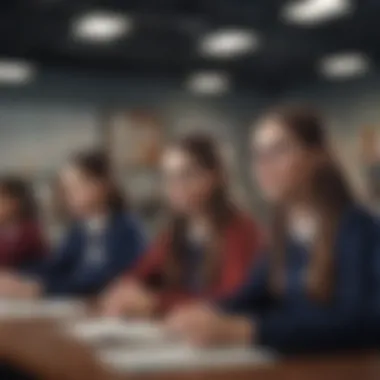Exploring the Best Private Middle Schools for Your Child


Intro
The landscape of middle education is intricate, particularly when it comes to the realm of private institutions. Parents seek avenues that offer not only robust academic frameworks but also facitate diverse extracurricular options and unparalleled support for students. In this article, key components of private middle schools will be explored thoroughly. Academic excellence will be dissected, alongside evaluations of student support services and the range of extracurricular opportunities. Additionally, the insights provided will empower parents to navigate their choices effectively, aligning their values and expectations with the school culture.
Understanding Private Middle Schools
Private middle schools present distinct advantages over other educational structures. These advantages include smaller class sizes, tailored academic programs, and the capacity to focus closer on individual student needs. Further, a strong privacy allows these institutions to maintain high educative standards beyond conventional measures. Let's deeply probe the characteristics that define these schools, while acknowledging the considerations families should keep in mind.
Academic Excellence
Curriculum Diversity
Top private middle schools pride themselves on offering a broad spectrum of curricula. Traditional subjects are often complemented by advanced offerings in STEM, Humanities, and Arts. Emphasis on critical thinking and problem solving is notable. Many institutions also provide challenging advanced placement courses as compared to typical curriculum.
Faculty Expertise
The severity of instructor qualifications contributes to an enhanced learning environment. Many private institutions manage to attract and retain well-established educators with impressive academic backgrounds. These abilities, paired with mentorship capabilities, create inspiring implications for academic cultures.
Measurement and Assessment
Performance measures tend to result considerably in standardized tests.School's ability to consistently maintain high scores reflects the educational quality on offer and indeed its effectiveness.
Extracurricular Opportunities
One cannot discount the importance of extracurricular activities in the overall development of middle schoolers. Not only do such opportunities enrich student's lives, but they also hone critical soft skills such as teamwork and leadership.
- via organized sports, students learn perseverance.
- Arts programs polish creativity; supporting the holistic educational approach.
- Clubs cater various interests, helping to instill a sense of belonging among peers.
Student Support Services
A defining trait of successful private middle schools is their commitment to student support. Essential services generally encompass counseling, academic advising, and parent engagement programs. Engaged faculty and administration often lead these initiatives, demonstrating an evolving awareness of varied academic and emotional needs.
Considerations for Parents
Choosing the right school for a child is seldom straightforward. When weighing private options, parents should consider financial commitments, locations, and potential fit for their children's academic style. Here are essentials for parents:
- Evaluate financial feasibility, factoring in tuition, supplies, and extracurricular costs.
- Investigate school reputation and potential alumni success to determine overall quality.
- Consider location and transportation, making sure it's manageable for family routines.
- Ensure school values align with family's principles to avoid mismatch in education philosophy.
It is crucial to approach the search process systematically. Begin by aggregating potential schools meeting discussed criteria, visiting them, and conversing with educators and current students to gain firsthand insights.
Expert Insights and Tips
It's helpful to consult online platforms for reviews or discussions. Resources like Reddit offer valuable external opinions regarding specific institutions. Engaging with local domains on social media networks might further substantiate your knowledge base.
“Educational choices define the trajectory of a child's future; thoughtful evaluation is key.”
By synthesizing the insights attained through research, visits, and dialogues, embarking on this journey may ultimately shepherd parents into achieving a satisfying decision for their young scholars. Enhanced consideration of these previously stated elements concerning selection process invites successful outcomes leading to thriving educational experiences.
Understanding Private Middle Schools
Private middle schools play a significant role in the academic landscape, offering an alternative to public education. Their importance stems from various factors, which include educational techniques, student-teacher interactions, and an array of extracurricular systems. The nuances found in understanding private middle schools can greatly influence a student’s educational direction and future prospects.
Defining Private Education
Private education refers to schooling that is funded through tuition fees and private sources rather than through government funding. These institutions often establish their own educational standards, curricula, and administrative policies. As a result, private middle schools can provide a tailored educational experience that aligns with their defined vision and educational philosophy. Families opt for private institutions as they seek specific advantages, ranging from smaller class sizes to specialized programs in the arts or sciences. Understanding how these elements come together is essential for parents contemplating the best fit for their child's needs.
Historical Context


The history of private education dates back centuries, with such institutions often emerging to fill gaps left by parental fear of public schooling's adequacy. From very early on, private schools have aimed to provide students not just with knowledge, but also with distinct values and cultural enrichment. Historically, many elite families incorporated private nomenclature as a marker of social status. Over the years, trends emerged, allowing students from diverse socioeconomic backgrounds to attend well-funded private middle schools. This expansion is often linked with a variety of philanthropic efforts and educational reforms. Understanding this historical evolution enlightens the current environment within privates schools and illustrates the mismatches in educational equity that remain.
"Private middle schools have continuously adapted to meet the changing needs of families and students, contributing to their ongoing relevance in society."
To fully grasp the landscape of private middle schools, one must deliberately look into their definitions, as well as the nuanced paths that brought them to their present state. This approach lays a crucial foundation for understanding current practices and the overall dynamics of private education.
Benefits of Attending Private Middle Schools
Private middle schools offer several advantages that can significantly impact a child's education and personal development. It is vital to analyze these benefits when considering educational options for your child, especially when the landscape is increasingly competitive. This section uncovers crucial aspects that underscore the importance of private education, contributing to informed decisions by parents.
Smaller Class Sizes
One of the most lauded benefits of private middle schools is the smaller class sizes they tend to offer. With fewer students per classroom, teachers can provide individualized attention to each student. This closely supervised environment fosters stronger relationships between students and educators, making it easier for instructors to understand strengths and weaknesses of each child. Academic needs can be addressed more directly, helping students grasp complex concepts more efficiently.
Smaller classes also reduce the distractions of a busier classroom, leading to enhanced focus. Students in private middle schools may feel more comfortable expressing their thoughts and asking questions, contributing to a more vibrant classroom discussion. As such, this environment often produces higher levels of academic achievement and increased confidence among students.
Personalized Learning Approaches
Private middle schools often implement personalized learning approaches that cater to the unique needs of each student. This practice allows educators to devise strategies that better align with students’ varied learning styles. Teaching methods may include student-led discussions, hands-on activities, or technology-assisted assignments.
An increasingly popular element of personalized learning is the integration of the latest educational technologies. Through adaptive learning software and individual assessments, teachers can effectively track progress and make necessary adjustments to lesson plans. This level of flexibility prepares students to flourish in a changing world. Furthermore, personalized feedback reinforces a student's understanding of their performance, cementing their eagerness to learn and develop.
Enhanced Extracurricular Opportunities
Another distinguishing feature of private middle schools is the breadth of extracurricular opportunities available. These schools typically offer a wider variety of activities beyond academics, including athletics, arts, and community service programs.
Engagement in extracurricular activities promotes well-rounded development. When students participate in sports, arts, or clubs, they acquire not only teamwork skills but also leadership abilities. Furthermore, these opportunities can serve as a foundation for exploring future passions. Many schools are known for specialized programs, which can impress future high school or college admissions boards.
Students engaged in extracurriculars also form strong connections outside their typical social circles. Building relationships through cooperative activities encourages social development, which is essential during the formative middle school years.
In summation, the benefits of attending private middle schools are manifold, culminating in a rich, multifaceted educational experience that strives to prepare students for future academic and personal success.
Criteria for Selecting a Private Middle School
Selecting a private middle school is a significant decision for parents and can shape a child's educational experience. This criteria ensures that families choose a school that aligns with their values and expectations. The key elements to consider while making this decision include not just academic performance, but also factors such as school culture, location, and financial feasibility. Understanding these criteria helps in evaluating what a school can offer and how well it fits into a child's future.
Academic Performance and Curriculum
In assessing academic performance, a school’s overall educational outcomes should be paramount. Metrics such as standardized test scores, college placement rates, and the qualifications of the faculty weigh heavily in this evaluation. Private middle schools often have tailored curricula that may include advanced courses in scientific and mathematical disciplines.
Here are some specific factors to assess:
- Curriculum Diversity: Schools should provide a wide range of subjects including in arts and technology.
- Academic Programs: Programs such as International Baccalaureate or Advanced Placement may be advantageous.
- Classroom Environment: Look for low student-to-teacher ratios which could indicate more personalized instruction.
Collecting this information might involve visiting schools, speaking to faculty, and reviewing academic handbooks. Insight into frequent curriculum assessments can further define a school's commitment to continuous educational improvement.
School Culture and Values
The alignment of personal values with those of the school is crucial for fostering a beneficial learning environment. A school’s culture includes its mission statement, policies on discipline, and practices that honor diversity and inclusion.
Consider observing:
- Community Involvement: Schools that actively engage with their local community may offer broader life experiences for students.
- Ethics and Norms: The values promulgated by school administration can profoundly influence student’s social development.
- Support Resources: Look for resources like counselors and mentors which show support for students’ emotional and social wellbeing.
A school visit can provide first-hand insights into the cultural environment, allowing parents to gauge if their child would feel comfortable there.
Location and Facilities


The physical location and quality of facilities can have unforeseen impacts on student experience. Proximity to home can reduce stress related to lengthy commutes. Moreover, the condition and accessibility of school facilities directly influence day-to-day life for students.
Key aspects to observe might be:
- Safety of the Neighborhood: A secure environment is key for starting independence during the formative years.
- Recreational Areas: Well-maintained sports fields, art rooms, and science labs enhance the learning experience.
- Accessibility: Ensure that facilities are equipped to serve students with special needs.
Taking time to explore facilities during the application process can ensure that parents are confident in their choice.
Tuition and Financial Aid Options
Affordability often stands as a barrier for many families considering private education. Understanding the full financial landscape is critical. This includes evaluating tuition fees, types of payments, and available financial help.
Important points include:
- Tuition Rates: Research if the school has hidden fees in addition to tuition.
- Financial Aid Options: Inquire whether scholarships or payment plans are available.
- Long-Term Value: Calculate the potential return on investment in terms of educational quality and outcome.
Navigating financial aspects can require open conversations with finance departments of schools to understand the nuances and available options.
“Criteria used in selecting a school can vary, but the child’s needs should always remain central from the start.”
In sum, selecting the right private middle school involves a thorough examination of these varied criteria. Attention to detail here can provide valuable insight into building a well-structured educational trajectory for your child.
Notable Private Middle Schools
Notable private middle schools serve as a cornerstone in enhancing quality education in America. Their importance lies in their ability to offer tailored educational experiences that exceed traditional public school standards. Notable institutions foster environments where academic rigor, social growth, and personal development intersect. When considering a private middle school, parents tend to evaluate these prestigious institutions which are often populated with resources, innovation in teaching, and strong alumni networks.
Top Institutions in the U.
S.
The landscape of private middle schools in the United States is populated by several exemplary institutions that have risen above others in various aspects of education. Factors like academic achievements, access to advanced technologies, and unique programs define these top-level schools. Some notable private middle schools include:
- The Dalton School in New York City focuses heavily on individualized learning and innovative teaching strategies.
- Sidwell Friends School in Washington, D.C., known for its strong emphasis on values and its rigorous academic curriculum.
- Oakwood School in California, which encourages creativity and responsibility among students while offering diverse extracurricular activities.
These schools demonstrate consistently high academic performance. They often have remarkable college matriculation rates, attracting discerning parents searching for the best educational opportunities for their children.
Additionally, they often provide ample resources including state-of-the-art technology, substantial personal attention through smaller class sizes, and comprehensive programs for sports, arts, and service.
Emerging Schools of Distinction
As education evolves, new private middle schools are emerging with a unique character. These schools are often designed with modern educational needs in mind and prioritize contemporary learning outcomes. They embrace new teaching methodologies and invest in engaging extracurricular programs. Some examples include:
- The Nova School in Florida, which implements project-based learning deeply rooted in real-world connections, engaging students with the local community and environment.
- The Green School NYC, offering experiential learning opportunities combined with environmental consciousness as a core educational aspect.
- Europe's International School in Maryland, setting itself apart with its bilingual education structure for a diverse culture.
Emerging institutions are gradually gaining recognition alongside established names due to their innovativeness and commitment to fostering an inclusive environment. Parents who seek not only traditional education but also comprehensive growth may find these schools appealing.
Emerging schools of distinction often address the modern context of education, enhancing engagement and learning skills for future challenges in academic and real-world settings.
In summary, understanding the notability of various private middle schools is crucial for parents during their school selection process. These institutions demonstrate a wide array of strengths and innovations, providing invaluable benefits that can shape a student's academic and social trajectory.
Challenges Faced by Private Middle Schools
Understanding the challenges encountered by private middle schools is essential. These institutions, while offering certain advantages, are not without their own set of difficulties. The topic is relevant because it affects educational quality and accessibility for students and families. By recognizing these challenges, parents and educators can work towards solutions that promote equity and improvement in private education.
Accessibility and Affordability
Accessibility to private middle schools is a major concern for many families. Tuition fees often reach high amounts, making it difficult for some families to afford. Many private schools have costs that exceed $30,000 per year. As a result, the question of whether a private education is a financial strain arises.


• Financial aid options exist, but they may not be broad enough to meet rising demand. • Families often find that middle schools affiliated with religious organizations tend to be less expensive, but they still may not fit into every budget.
This financial pressure can lead to a narrowing of options for qualified students who are not able to afford tuition. Parents should consider financial assistance when evaluating their options. Increased fundraising and scholarship programs may help alleviate some of the strain; however, significant gaps remain.
Diversity and Inclusion Issues
Need for diversity and inclusion is another significant challenge for private middle schools. Many schools struggle to attract and retain a diverse student body. Often, families from affluent backgrounds dominate enrollment, leading to a lackluster mix of perspectives and experiences in the classroom. This homogeneity can impact the overall learning environment, limiting social growth for all students.
Key points regarding this issue involve:
- Schools may implement programs to improve outreach to underrepresented communities, but progress can be slow.
- The absence of diverse role models for students can affect their understanding of the world.
Programs that seriously focus on inclusivity are essential to foster a richer educational environment. Addressing both accessibility and diversity can enhance the quality of education. It creates a space where all students can prosper in varying backgrounds and abilities.
Addressing the challenges faced by private middle schools requires conscientious effort from both educators and families to ensure all students have access to quality education, regardless of their circumstances.
Solving these issues helps private middle schools become spaces where students thrive academically and personally.
Future of Private Middle Schools
The landscape of private middle schools is undergoing significant changes. As society evolves, so do the needs of students and parents. This section explores those changes and considers future directions while focusing on the specific elements pertinent to personal and societal growth. Understanding these shifts is important for stakeholders, including educators, families, and policymakers, as they influence current options and inform strategic decision-making.
Trends in Education
Education continually adapts to reflect both societal changes and pedagogical innovations. Current trends affecting private middle schools include project-based learning, social-emotional learning, and interdisciplinary approaches. The rise of competency-based education, which emphasizes mastery of skills over traditional grading systems, is notable.
Some prominent trends include:
- Focus on individual learning: Schools increasingly prioritize personalized learning paths that cater to each student's unique needs. This approach fosters a deeper understanding and appreciation of the curriculum.
- Interdisciplinary curriculum: Integrating subjects helps engage students more fully in their education. For example, combining science with art or history can create stimulating learning experiences that ignite curiosity.
- Social-emotional learning (SEL): Addressing social and emotional competencies is gaining importance. Programs in private middle schools often focus on helping students develop self-awareness and interpersonal skills, which are essential for lifelong success.
These trends come with challenges, such as adequately training educators and allocating resources. However, they represent crucial steps towards achieving educational excellence in private institutions.
Technological Integration
As education progresses, technological integration plays a key role in shaping the future of private middle schools. The incorporation of advanced tools impacts not just instructional methods, but also student engagement and retention.
The focus areas of technology in education include:
- Blended learning: Combining in-person instruction with online components creates a flexible environment that appeals to diverse learning styles. Blended learning models promote student agency and allow for adaptable pace.
- Life skills and 21st-century competencies: Fostering skills such as critical thinking, collaboration, and digital literacy prepares students for success in an ever-evolving job market. Curricula now include critical digital literacy components.
- Data-driven decision making: Technology provides a wealth of data that schools can analyze to improve educational outcomes. Utilizing this data can help identify students who need extra support, thereby enhancing individual pathways toward mastery and academic success.
“The future belongs to those who prepare for it today.” - Malcolm X
Key considerations for future developments include securing resources for ongoing technology updates and ensuring equitable access for all students.
Through attention to these themes, private middle schools can maintain relevance and provide high-quality education tailored to individual needs while embracing future trends.
Closure
The conclusion of this article underscores the critical insights into private middle schools. Understanding the dynamics of private education is essential for families navigating choices about their children's schooling. Private schools distinguish themselves through academic rigor, varied extracurricular programs, and supportive learning environments. These institutions are designed to cater to individual student needs in ways that larger public schools may struggle to achieve.
Selecting a school for one's child entails a range of considerations. First and foremost, parents must assess academic performance. Gary Baker Associates highlights that a strong curriculum often leads to superior outcomes. Additionally, parental preference for smaller class sizes aligns with findings that indicate better student engagement.
Social factors and values entwined within a school's culture cannot be overlooked. A school that aligns with a family's ethos is often most beneficial for students. The location and amenities fundamentally affect daily life and convenience. Moreover, financial implications are crucial. Investigating tuition alongside available aid options allows families to realistically approach a school's feasibility.
"Education is not the filling of a pail, but the lighting of a fire." - W.B. Yeats
In summary, Bogardi & Associates assert that embracing the multifaceted benefits of private education helps to create an informed decision-making process. For parents and guardians, balancing these criteria alongside their children’s aspirations and needs culminates in an impactful education path. As we conclude, it becomes evident that a well-rounded understanding of private middle schools empowers parents to utilize their options more effectively. This makes the journey meaningful not just for students but for their families as well.
Final Thoughts on Private Education
Ultimately, the experience provided by private middle schools can significantly alter a child's education journey. Fostered through an array of advancements, private schools are often perceived as gateways to consistent academic improvement and personal growth. Well-curated programs, solid mentoring systems, and a commitment to individual success foster learning environments distinct from others. Families should weigh these factors carefully, as each element shapes educational experiences tremendously.
By contemplating the information compiled within this comprehensive guide, parents are better equipped to grasp the importance of selecting the right educational institution for their children. Thus, they can forge partnerships with schools in a manner that maximizes learning opportunities, reaching the ultimate goal: nurturing curious, competent, and knowledgeable future leaders.







